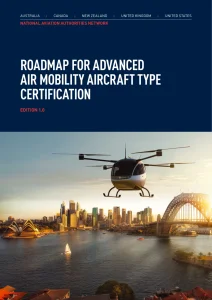- Directory
- Advanced Air Mobility White Papers
- Advanced Air Mobility (AAM)
- Roadmap for Advanced Air Mobility Aircraft Type Certification Edition 1.0
Roadmap for Advanced Air Mobility Aircraft Type Certification Edition 1.0
White Paper Details
This roadmap establishes a collaborative, harmonized approach among five national aviation authorities to certify advanced air mobility (AAM) aircraft. Centered on safety, innovation, and streamlined validation, it sets six guiding principles to align certification standards and bilateral agreements, enabling efficient approval and operation of emerging AAM technologies globally.<!-- notionvc: 70cb2835-6593-450b-bd6c-67669b5d0298 -->
The "Roadmap for Advanced Air Mobility Aircraft Type Certification Edition 1.0" presents a unified strategy by the National Aviation Authorities (NAA) Network—representing Australia, Canada, New Zealand, the UK, and the U.S.—to address the complex certification challenges introduced by emerging advanced air mobility (AAM) technologies, particularly electric vertical takeoff and landing (eVTOL) aircraft. The document emphasizes six key principles to foster safe and efficient integration of AAM aircraft within global aviation.
The roadmap outlines a three-phased approach to harmonized type certification: applying performance-based requirements, converging differing airworthiness criteria among the network members, and adopting mutually accepted means of compliance.
It recognizes current differences, such as between FAA and UK CAA criteria, and promotes convergence through collaborative validation efforts, streamlined assessment, and multi-authority validation programs that optimize resources and reduce duplication.
An incremental “crawl, walk, run” certification model supports the certification of piloted AAM first, followed by increasingly autonomous remotely-piloted variants. The roadmap stresses the importance of bilateral agreement updates to incorporate AAM-specific provisions, promoting regulatory harmonization and transferability of certifications. It advocates ongoing dialogue with standards development organizations and industry to uphold safety while accommodating innovation.
Implementation involves coordinated efforts in sharing certification information, reviewing bilateral agreements, expanding membership, and engaging stakeholders. The roadmap aims to serve as a living document, evolving as technological advancements and regulatory needs mature, ultimately establishing the NAAN as a global leader in AAM regulatory convergence and safety assurance.
<!-- notionvc: 748d70c6-4857-4a1d-9b42-cfde56fb1435 -->
